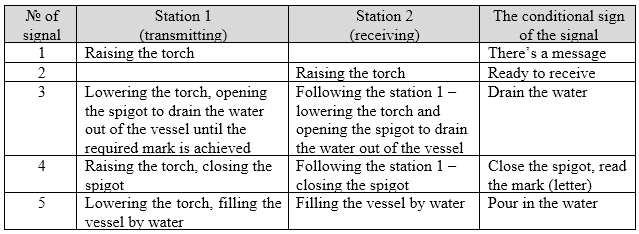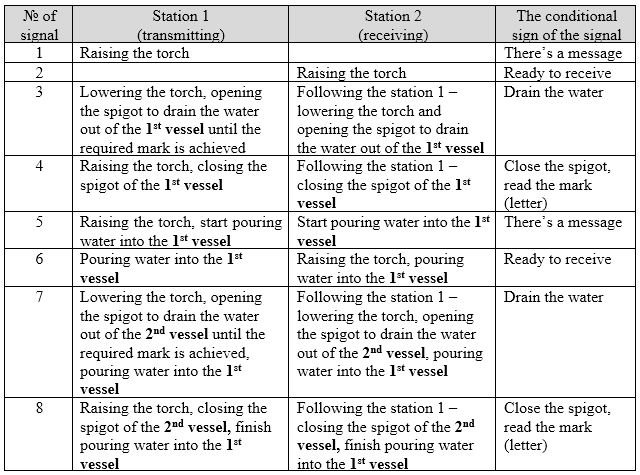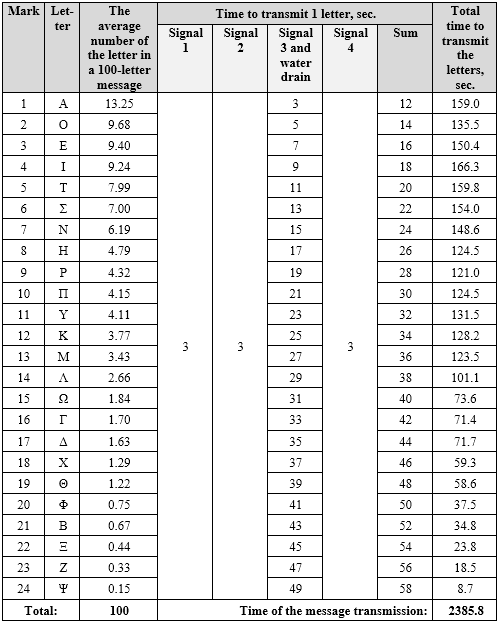Срочная публикация научной статьи
+7 995 770 98 40
+7 995 202 54 42
info@journalpro.ru
Antique hydraulic telegraph: refinement of the data transfer rate in Ancient Greece by an experiment and a mathematical model
Рубрика: Исторические науки
Журнал: «Евразийский Научный Журнал №1 2024» (январь, 2024)
Количество просмотров статьи: 166
Показать PDF версию Antique hydraulic telegraph: refinement of the data transfer rate in Ancient Greece by an experiment and a mathematical model
Kulikova Milena
Secondary General Education School «Stolichny–KIT»
E-mail: 3345dsafgh@gmail.com
1. Introduction
Antique hydraulic telegraph (AHT) is a device for communication which was invented in Ancient Greece in 4th century BC. Its description was found in books of Polybius [1] with reference on Aeneas Tacticus (the text of Aeneas about AHT wasn’t saved).
AHT is a vessel (a jug) with the spigot at the bottom, water is filled into such vessel and a cork with the rod is placed above water, the rod is graduated in 24 marks (there are 24 letters in the Greek alphabet). AHT stations were located on some hills or fortress walls. In AHT teams also were signalers with torches. They were working according the technology, showed in table 1.
Table 1. Technology of AHT by description of Polybius (1 cycle)

At the receiving station, at signal 4, they looked at the mark to which the rod had got down and recorded it. The cycle was repeated until all the letters of the message were transmitted.
In 2016, the author carried out an experiment to measure the data transfer rate of AHT, the result was 50 letters per hour [2].
2. Rearranging letters and a new experiment
According to the conclusion of this experiment, the following possibilities were found to increase the AHT speed of work:
1) Rearrange the letters on the rod of the AHT, not alphabetically, but according to the frequency of their occurrence in Greek texts. In the former experiment the
To estimate such rearrangement, there should have data about letter frequencies in Greek texts, they were kindly provided by Stefan Trost [4].
2) Add one more person and one more vessel to each station so that while water is being poured into one, it is possible to transmit messages on the other. For example, according to the scheme from Table 2:
Table 2. Advanced technology of AHT (2 cycles)

Thus, the cycle of 4 steps for the 1st vessel remains, but then the cycle for the 2nd vessel starts, and water is poured into the 1st at this time. In other words, the vessels work alternately, and due to this, the loss of time for pouring water is eliminated: it is performed as a background process.
The only possible problem is whether there will be enough reserve time to pour the water? It will be minimal in the case when water is poured into the 1st vessel after the transmitting of the 24th mark (‘psi’), while only one letter message corresponding to the 1st mark (‘alpha’) is transmitted on the 2nd vessel. Then the time limit will be determined by the duration of 6 signals:
— Signal 4 for the 1st vessel;
— Signals 1, 2, 3 and 4 for the 2nd vessel;
— Signal 1 again for the 1st vessel.
With the duration of each signal for 3 seconds — the limit is 18 seconds.
To check whether it is possible to meet such a limit, the author organized an experiment in which the time for pouring water into the vessel after drain the water to the 24th mark was measured. 25 measurements were made, i.e. the measurement error is estimated at 20%. Result is 13.3 ± 2.7 seconds, i.e. it’s possible to keep within the limit of 18 seconds.
3. AHT mathematical model
Based on the above data, a mathematical model of AHT was created (Table 3). The marks got letters according to their frequency [4], from the highest to the lowest. The average expected number of a given letter in a
Table 3. AHT mathematical model for 100 letters

The time for the transmission of letters (signals
— Signals 1, 2 and 4 are 3 seconds each;
— Signal 3 and water drain is by the formula 2n+1 sec., where n is the number of the mark.
Their validity is confirmed by the 2016 experiment.
4. Results and conclusions
According to the calculation based on the mathematical model, it would take an average of 2385.8 seconds to transmit a message of 100 letters using advanced technology of AHT, i.e. the data transfer rate would be
100 : (2385,8 / 3600) ≈ 151 letter/hour.
For comparison: in the Chappe brothers’ optical telegraph line in 1794 Paris-Lille, the first character passed through 15 stations in 9 minutes [5]. Since each station repeated it, it turns out that the time to transfer one character from station to station was (9×60) / 15 = 36 seconds. Thus, the data transfer rate of the optical telegraph can be estimated at 100 letters/hour, i.e. the AHT could be faster than it.
Based on this, we can draw conclusions:
— AHT in terms of data transfer rate could exceed the most powerful similar system of the late XVIII — early XIX century;
— The data transfer rate of the Napoleon Bonaparte era (about 2 centuries ago from our time) was still lagging behind the level of antiquity (while the difference between them was more than 2000 years), and only the invention of the electric telegraph and Morse code in the 1840s was able to increase it by an order of magnitude (over 1000 letter/hour);
— Communication has been and remains one of the main factors that determine the development of the civilization;
— Data transfer rate is a quantitative parameter by which the level of development of society in the present and in the historical retrospective can be compared.
Reference list:
1. Polybius. The Histories / Book X,
2. Kulikova, Milena (2016) ‘Antique hydraulic telegraph: tranmission rate in experiment’, Eurasian Scientific Journal (Евразийский научный журнал), 9, p. 89.
3. Collected papers (2003) The military art of antiquity (Военное искусство античности), K. Korolyov as the compiler, Moscow: Eksmo.
4. Trost, Stefan. Letter Frequencies of the language Greek (https://www.sttmedia.com/characterfrequency-greek).
5. Viennot, Laurent. Une brève histoire des réseaux de télécommunications (https://interstices.info/une-breve-histoire-des-reseaux-de-telecommunications).









